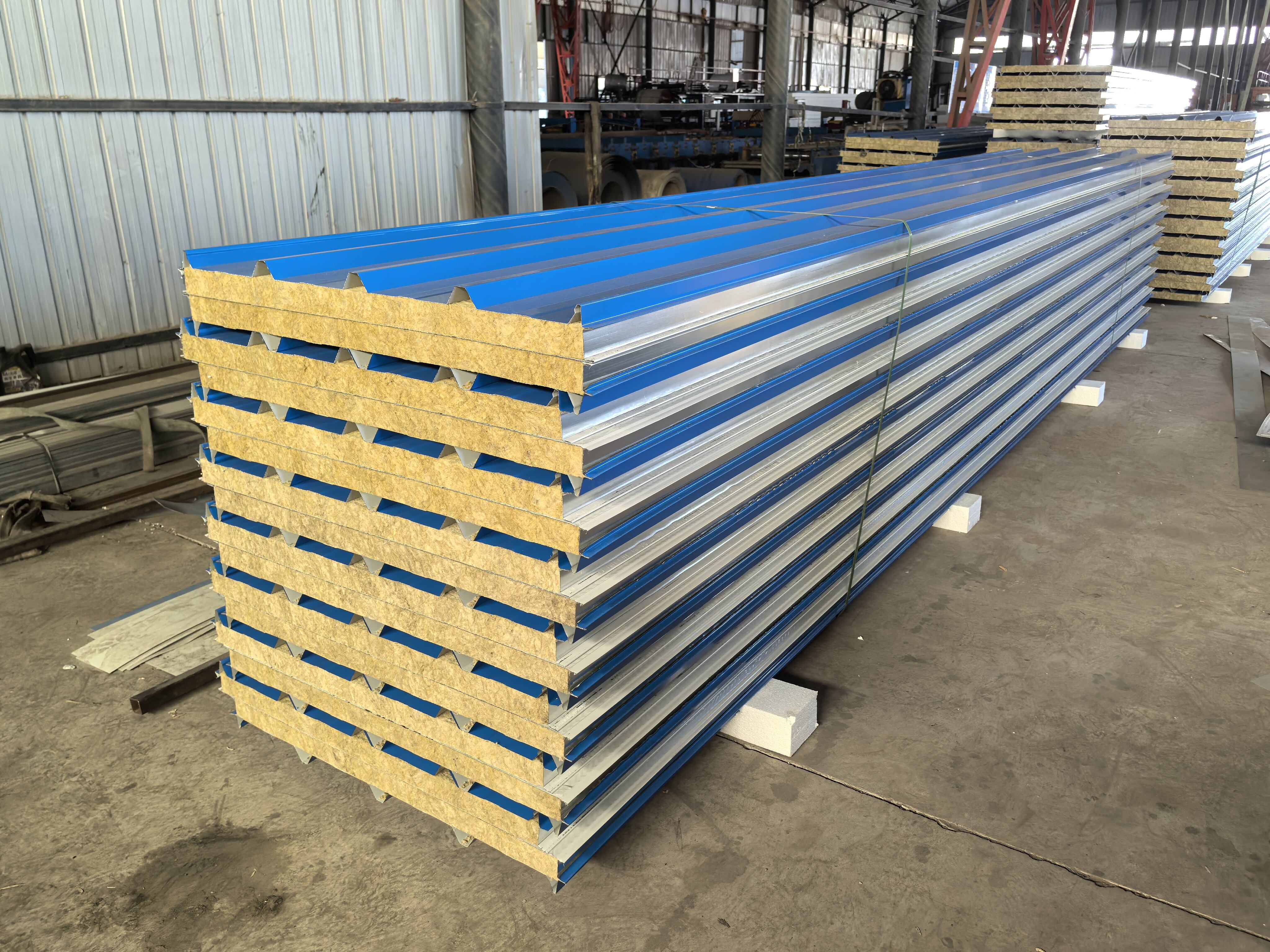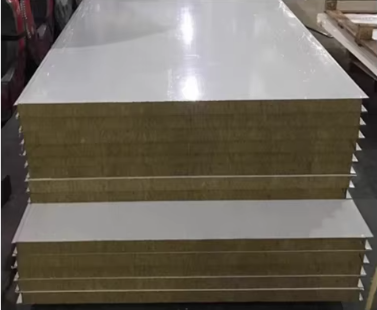Manufacturing and Composition of EPS Sandwich Panels
Core Materials: Understanding Expandable Polystyrene
Expandable Polystyrene (EPS) is a foam plastic material known for its versatility in various applications, especially in construction, packaging, and insulation. EPS originates from small polystyrene beads that can expand up to 50 times their original volume when exposed to steam heat. This expansion process forms a lightweight, yet rigid material suitable for a range of applications. When manufacturing EPS sandwich panels, selecting high-quality EPS is crucial for ensuring the panels' structural integrity and longevity. Using premium EPS helps in maintaining consistent quality and effectiveness in insulation and durability.
Production Process: CFC-Free Manufacturing Techniques
The production of EPS sandwich panels involves a series of well-coordinated steps, beginning with raw material selection and culminating in panel finishing. Initially, the chosen EPS beads undergo expansion through controlled heating. This step is crucial in defining the density and insulation properties of the final panel. Following expansion, the beads are molded into the desired panel shape and size under pressure. It's important to note that modern manufacturing techniques for EPS panels are CFC-Free, significantly reducing the environmental footprint. By adopting eco-friendly production methods, manufacturers contribute to meaningful reductions in harmful emissions, supporting sustainable construction practices.
Material Properties: Balancing Density and Insulation Value
In EPS sandwich panels, the density of the core material directly influences its insulation performance. Higher density panels typically offer superior insulation but may come at an increased material cost. Finding the right balance between density and insulation value is key to achieving cost-efficiency and energy performance in buildings. According to industry data, optimized EPS panel configurations can lead to substantial energy savings, reducing heating and cooling costs in residential and commercial structures alike. By leveraging these material properties, builders and architects can design energy-efficient solutions that are both economically and environmentally advantageous.
Key Benefits of EPS Core Construction
Superior Thermal Insulation with Low K-Values
EPS sandwich panels are renowned for their exceptional thermal insulation, with K-Values as a crucial measure of their effectiveness. K-Values, or thermal conductivity values, indicate how well a material prevents heat transfer. Lower K-Values mean better insulation, thus enhancing energy efficiency. The superior insulation properties of EPS can significantly reduce heating and cooling costs in residential and commercial buildings. By minimizing energy losses, these panels contribute to a comfortable indoor environment and lead to cost savings over time. For instance, insulated structures can achieve up to 50% energy savings compared to uninsulated ones, making EPS panels essential for sustainable construction projects.
Lightweight Design: Under 10 kg/m² for Easy Handling
One of the striking advantages of EPS sandwich panels is their lightweight design, typically weighing less than 10 kg/m². This attribute facilitates effortless transportation and installation, streamlining construction processes and reducing labor demands. Lightweight panels contribute to ergonomic benefits, minimizing physical strain on workers and expediting project timelines. Studies have demonstrated that utilizing lightweight construction materials like EPS panels can cut labor costs by up to 20%. Such efficiency not only benefits builders by reducing on-site time but also enhances overall project management, offering a practical solution for various construction applications.

Moisture Resistance in Humid Environments
EPS's closed-cell structure plays a pivotal role in providing moisture resistance, making it ideal for use in humid conditions. This structural characteristic ensures that EPS panels resist water absorption, maintaining their integrity and insulation properties even in damp environments. Moisture resistance is crucial for applications such as cold storage and durable infrastructure, where maintaining optimal conditions is vital. Expert studies affirm the reliability of EPS in humid climates, emphasizing its performance stability and reduced susceptibility to moisture-related issues. Consequently, EPS panels are highly regarded for applications requiring high humidity endurance.
Cost-Efficiency Across Project Lifecycles
EPS sandwich panels offer significant cost-efficiency benefits throughout a project's lifecycle, from initial construction to ongoing maintenance. Their superior energy efficiency translates into long-term savings, lessening the financial burden on both homeowners and businesses. The return on investment (ROI) is favorable due to reduced energy consumption and enhanced durability, making EPS panels a financially sound choice. Research suggests that lifecycle costs of buildings constructed with EPS panels can be 30% lower compared to traditional materials, underscoring their economic advantage. The integration of EPS panels thus aligns with contemporary demands for efficient, sustainable building solutions.
Industrial and Commercial Applications
Cold Storage Warehouses and Refrigerated Transport
EPS sandwich panels play a crucial role in maintaining consistent temperatures within cold storage warehouses and refrigerated transport. These panels ensure that perishable goods are preserved by providing superior thermal insulation, which is vital for meeting regulatory standards in temperature-controlled environments. In fact, studies have shown that using EPS in these settings can substantially reduce energy consumption due to its low thermal conductivity. For instance, in refrigerated transport, EPS helps maintain optimal interior temperatures, reducing the need for constant energy input to manage cooling systems. By helping facilities adhere to strict regulatory standards, EPS sandwich panels are indispensable in the cold storage and refrigerated transport industries.
Poultry Houses and Agricultural Climate Control
Poultry houses require specific environmental control to maintain optimal conditions for livestock health and productivity, and EPS sandwich panels meet these needs effectively. These panels provide excellent thermal insulation, helping to regulate temperature and humidity levels crucial for poultry welfare. A study in agricultural applications highlighted EPS's role in enhancing climate control, resulting in healthier livestock and increased egg production. A key insight from industry experts is that proper insulation using EPS reduces heat stress in poultry, thus improving overall productivity. These benefits make EPS panels a preferred choice for agricultural buildings aimed at optimizing livestock conditions.
Temporary Structures and Modular Site Offices
EPS panels offer several advantages for temporary structures, such as modular site offices, due to their ease of assembly and disassembly. These lightweight panels are straightforward to install, making them ideal for construction sites and event management settings that require flexibility. For example, a recent project utilized EPS panels to create a series of portable offices that could be easily moved and reassembled as needed, showcasing the panels' versatility. The benefits of such modular constructions include reduced labor costs and efficient space management, making EPS an ideal option for temporary and rapidly deployable structures.
Sustainability and Environmental Impact
Recyclability and Circular Economy Contributions
Recyclability is a vital aspect of EPS, particularly in contributing to environmental sustainability. EPS, or expanded polystyrene, is recognized for its recyclability, allowing it to be reused in various applications, such as creating new polystyrene products, insulation, or even as plant containers. These practices support the principles of a circular economy by minimizing waste and encouraging continued resource use. By cycling EPS materials back into production, industries not only reduce waste but also conserve energy and raw materials. An example of a successful recycling initiative is the EPS Industry Alliance's program, which has seen significant success in transforming used EPS into new products. Thus, EPS's recyclability is a key factor in promoting a sustainable future.
Meeting Green Building Certification Standards
EPS is increasingly becoming a crucial material in achieving green building certifications like LEED. By offering superior insulation, EPS helps enhance energy efficiency in buildings, a critical element in such certifications. This material meets several green certification criteria, including energy performance, resource efficiency, and indoor environmental quality. Statistics indicate that numerous structures have attained green certifications using EPS, driven by its insight into reducing a building's carbon footprint while maintaining thermal efficiency. Therefore, EPS proves to be a valuable asset in the realm of eco-friendly construction, meeting rigorous environmental standards and contributing to a more sustainable built environment.
Advances in Bio-Based EPS Formulations
Recent advancements in bio-based EPS formulations are setting new sustainability benchmarks in the construction industry. Researchers are developing EPS alternatives with reduced environmental impact, responding to market demand for eco-friendlier solutions. This trend reflects broader environmental benefits, such as lower carbon emissions and decreased reliance on fossil fuels. Experts in the field like those at Grand View Research highlight these formulations as game-changers for meeting both industry demands and sustainability goals. With market analysis suggesting an upward trajectory for these eco-friendly alternatives, bio-based EPS is carving a niche as a sustainable solution for future constructions.
Installation Advantages and Maintenance
Rapid Assembly for Construction Timelines
EPS panels are a game-changer when it comes to reducing construction assembly time compared to traditional building materials. The efficiency of EPS panels allows for faster installation, significantly shortening project timelines. For instance, projects utilizing EPS panels have reported up to a 50% reduction in construction time, which directly impacts project delivery schedules. Such rapid assembly not only accelerates the timeline but also reduces labor costs, benefitting contractors and developers. Testimonies from contractors have highlighted that quicker assembly with EPS panels enables them to meet tight deadlines without compromising on quality.
Minimal Maintenance Requirements
One of the standout features of EPS sandwich panels is their minimal maintenance requirements, which translate into substantial long-term savings for property owners. EPS panels are highly durable in various environmental conditions, offering excellent resistance to rot, pests, and moisture. This durability makes them a preferred choice in climates with extreme weather fluctuations. According to data, maintenance costs for EPS panels are significantly lower than those for traditional building materials, adding to the attraction of using EPS in construction. As a result, EPS panels not only ensure aesthetic and structural integrity over time but also reduce the financial burden of upkeep.
Retrofitting Existing Structures
EPS panels are not just limited to new constructions; they are also highly effective in retrofitting existing structures, enhancing insulation and reducing energy costs. By integrating EPS panels, older buildings can achieve modern energy efficiency standards, thereby decreasing heating and cooling expenses. This process often aligns with regulatory incentives for energy-efficient upgrades, making the transition economically advantageous. Success stories from retrofitting projects have demonstrated notable improvements in thermal insulation and energy efficiency, thanks to EPS integration. Such projects underline the practicality and cost-effectiveness of EPS panels in upgrading existing buildings to meet contemporary standards.
Emerging Trends in EPS Panel Technology
Fire Retardant Additives for Enhanced Safety
The growing need for fire-resistant construction materials has led to advancements in EPS technology, particularly the incorporation of fire retardant additives. These additives are essential in reducing the flammability of EPS products, thus enhancing safety. Compliance with international fire safety standards such as those set by ASTM and EN is crucial, ensuring that EPS panels meet stringent requirements for construction use. As evidence of their efficacy, many structures using enhanced EPS have reported fewer fire incidents, illustrating the additive's protective capabilities. These advancements not only provide peace of mind but also boost the adoption of EPS in a variety of construction projects.
Regional Market Growth Projections
The EPS sandwich panels market is experiencing significant growth, especially in regions like Asia Pacific and North America. According to recent market research, the global market is projected to expand at a compound annual growth rate (CAGR) of 7.7% from 2024 to 2030. This growth is driven by an increasing demand for energy-efficient building solutions, supported by governmental policies promoting sustainable construction materials. Furthermore, the rising urban population and increased investment in infrastructure contribute to these favorable trends. As the awareness of energy conservation and environmental sustainability grows, so does the demand for EPS panels, situating them as a pivotal player in the construction industry's future.
Smart Panel Integration with IoT Systems
With the rise of smart building technologies, EPS panels are evolving to integrate IoT systems, offering new functionalities that enhance energy management and automation. These smart panels are instrumental in optimizing building operations by enabling real-time monitoring and control of environmental conditions. Studies have shown that incorporating smart technologies can lead to significant reductions in operating costs, providing both economic and environmental advantages. By merging EPS panel benefits with IoT capabilities, we can harness improved efficiency, making construction projects more sustainable and cost-effective. The integration of these technologies marks a transformative step in the evolution of building materials, catering to modern demands for smarter infrastructure.
Frequently Asked Questions
What are EPS sandwich panels commonly used for?
EPS sandwich panels are commonly used for insulation purposes in construction, such as in cold storage warehouses, modular offices, and poultry houses. They provide excellent thermal insulation, lightweight design, and moisture resistance.
How does the density of EPS impact its insulation efficiency?
The density of EPS affects its insulation efficiency, where higher density panels typically provide better insulation. However, this may also increase the material cost. Finding a balance between density and insulation value is crucial for cost-effective building solutions.
Are EPS panels environmentally friendly?
Yes, EPS panels are considered environmentally friendly due to their recyclability and contribution to energy-efficient building designs. They also support sustainable practices through CFC-free manufacturing processes.
Can EPS panels be used in humid environments?
Yes, EPS panels are suitable for humid environments because of their closed-cell structure, which provides excellent moisture resistance and prevents water absorption.
What advancements have been made in EPS panel technology?
Advancements in EPS panel technology include the incorporation of fire retardant additives for enhanced safety, bio-based EPS formulations for sustainability, and integration with IoT systems for smart functionalities in buildings.

 EN
EN







































